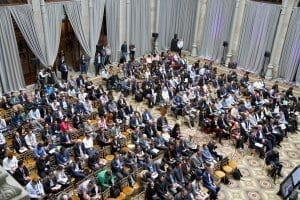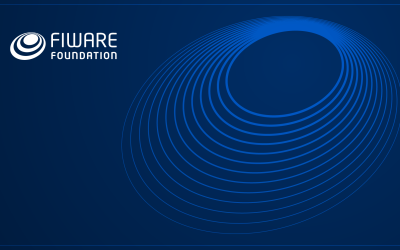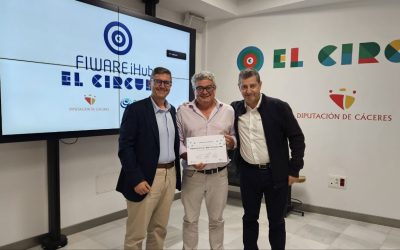In the following blog post, Valentijn de Leeuw, Vice President of ARC Advisory Group and Industry Specialist at Internet In Flanders, reflects back on the FIWARE Global Summit in May, 2018 in Porto, Portugal.
Progress and Outlook
The FIWARE Global Summit 2018 was held in the Palaço da Bolsa (the building of the historical stock exchange) in Porto. The meeting was kicked off by Hubert Tardieu, president of the Board of Directors. He reported on the governance of the FIWARE Foundation.
- A memorandum of understanding was signed with the International Data Spaces Association (formerly Industry Data Space Association, or IDSA) and the first open-source-based implementation of the IDS Reference Architecture was created.
- In March 2018, an independent review by the European Commission listed RAMI 4.0, IDS and FIWARE as top promising elements to realize digitization of Europe.
- ETSI released a preliminary specification of context information management standard API leveraging the FIWARE NGSI API, the standard for managing the lifecycle of context information.
Making FIWARE Easier to Understand
External advisors recommended making FIWARE easier to understand, [and to] develop elevator pitches for target audiences. They also recommended to create more visibility and broaden the target industry verticals, in particular smart energy [with an emphasis on] electric power. [Both are] important for Smart Cities and Smart Industry, which are already focus sectors.
Enforcing Data Protection with FIWARE and International Data Spaces
Certain levels of anonymization, aggregation, and the use of expiration dates will be needed to protect individuals. When transactions are stored in Hyperledgers such as blockchain, it is important to decide upfront which information is stored and which is (not stored but) linked-to in the ledger. The latter links are mutable and can be used to implement the right to be forgotten. FIWARE will be ready before the end of the year to make this possible. This addresses a real issue for smart solutions, illustrated by the fact that only three percent of smart electricity meters in France upload data, because of the lack of trust and capability to enforce data protection.
Spreading the Word
 CEO Ulrich Ahle explained the FIWARE Foundation has been listening to developers and users. Their feedback was confirmed by independent reviewers. FIWARE needs to become easier to understand and the organization commissioned a video that explains that harmonized data models and API’s create interoperability between data sources and applications. FIWARE aims at breaking down information silos across sectors, technologies and applications, and has the objective to provide open source and freely accessible enablers, help transforming data in information, as well as enabling data economy, ensuring sovereignty of data owners.
CEO Ulrich Ahle explained the FIWARE Foundation has been listening to developers and users. Their feedback was confirmed by independent reviewers. FIWARE needs to become easier to understand and the organization commissioned a video that explains that harmonized data models and API’s create interoperability between data sources and applications. FIWARE aims at breaking down information silos across sectors, technologies and applications, and has the objective to provide open source and freely accessible enablers, help transforming data in information, as well as enabling data economy, ensuring sovereignty of data owners.
Agreements for Cooperation
Mr. Ahle reported that at the Hannover fair, agreements were announced with ROS.org (fast RTPS technology, one of the FIWARE Generic Enablers, is adopted as default middle ware in ROS2), IDSA and OPC Foundation (with whom a first OPC-UA agent has been developed enabling the integration of OPC-UA with the FIWARE Context broker). Mr Ahle further explained the governance of FIWARE Generic Enablers, to guarantee they comply with FIWARE requirements of reliability, scalability, support, roadmap and adoption. He further explained that control of usage of user data mentioned above, will be based on IDS Reference Architecture 2.0, which enables the technical enforcement of policies and contracts.
Boosting the Digital Services Industry
David Raggett from W3C, known for his work on semantic interoperability, said seeing the opportunity for FIWARE to drive exponential growth of services through adoption of the web of things (or web of digital twins), and rely on linked data as framework for semantics, enabled using the FIWARE context broker. Data governance becomes very important, David said, not only to maintain data uploaded to cloud but keep it connected to correct metadata.
Smart Industry Sessions
After the plenaries the audience separated in smart cities, smart agriculture, smart industries and developer sessions. The smart industry sessions were composed of informative presentations followed by discussions between the panels of presenters and public. In first industry session, Sergio Gusmeroli of [Engineering S.p.A], pointed out that the alignment of RAMI 4.0, the IIC Reference Architecture, IDS and FIWARE implied the alignment of six pairs of concepts. Another industry panel focused on the projects that build upon earlier work on FIWARE. Several reference architectures were discussed building upon FIWARE and the IIRA, touching upon Edge, Fog and Cloud, and work on open analytics solutions to create value from IoT-data, independent from established providers.
FIWARE in the Industrial Smart Solutions Landscape
 I presented the existing and emerging automation and instrumentation connectivity landscape, the impact of open standards such as the those of the Open Automation Forum and the Namur Open Architecture to illustrate how IIoT connectivity is currently approached currently. I believe FIWARE can complement the acquisition of IoT data from low-cost sensors outside of the real-time deterministic closed-loop control in critical operations that is, added for monitoring and optimization purposes only. When DDS enters the industrial landscape through Open Automation Forum standards, and FIWARE would be aligned with IIRA, it would be thinkable that FIWARE, natively built for publish and subscribe mechanisms, could provide connectivity to the real-time databus layers, equivalent to the current fieldbuses. In SME’s and situations where critical, dangerous processes are absent, FIWARE, in combination with OPC-UA, may already today offer a low-cost broadly applicable solution for the development of (I)IoT solutions enabling these companies to take part in the digital economy. The combination of open source FIWARE with IDS connectors for policy and contract enforcement might be of great help to SME’s that would lack resources to develop bespoke solutions.
I presented the existing and emerging automation and instrumentation connectivity landscape, the impact of open standards such as the those of the Open Automation Forum and the Namur Open Architecture to illustrate how IIoT connectivity is currently approached currently. I believe FIWARE can complement the acquisition of IoT data from low-cost sensors outside of the real-time deterministic closed-loop control in critical operations that is, added for monitoring and optimization purposes only. When DDS enters the industrial landscape through Open Automation Forum standards, and FIWARE would be aligned with IIRA, it would be thinkable that FIWARE, natively built for publish and subscribe mechanisms, could provide connectivity to the real-time databus layers, equivalent to the current fieldbuses. In SME’s and situations where critical, dangerous processes are absent, FIWARE, in combination with OPC-UA, may already today offer a low-cost broadly applicable solution for the development of (I)IoT solutions enabling these companies to take part in the digital economy. The combination of open source FIWARE with IDS connectors for policy and contract enforcement might be of great help to SME’s that would lack resources to develop bespoke solutions.
Conclusion
The FIWARE Summit created awareness of this valuable resource that hadn’t significantly penetrated in the industrial automation conversations and literature, although it has significant adoption in smart cities and other sectors worldwide. It is definitely a technology to have on the radar to establish an industrial IoT strategy.
Presentations are publicly available at the following links: the plenary sessions and the Industry sessions.


